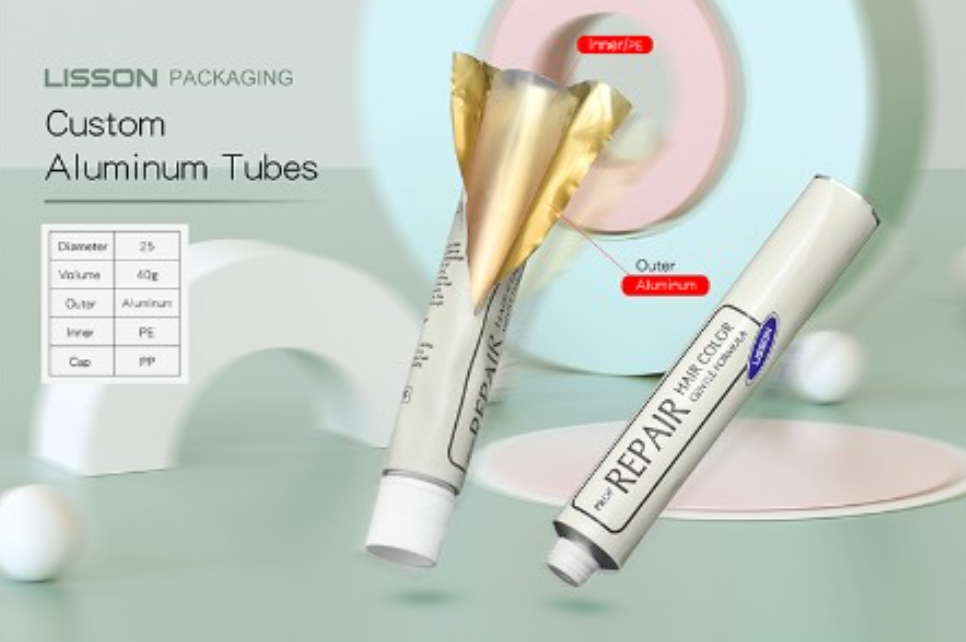Cosmetic squeeze tubes are convenient and hygienic to use, with bright and attractive surface colors. They are economical, portable, and even under high-pressure squeezing, they can still restore their original shape, maintaining a good appearance. Therefore, they have been widely used in the packaging of cream cosmetics, such as facial cleansers, conditioners, hair dyes, toothpaste, and other products in the cosmetics industry, as well as in the packaging of creams and ointments in the pharmaceutical industry.
Cosmetic tubes generally consist of a tube and a cap. The tube is commonly made of PE plastic, but there are also aluminum-plastic tubes, all-aluminum squeeze tubes, and environmentally friendly paper-plastic collapsible tubes, sugarcane bioplastic tubes, kraft paper tubes...
All-plastic tubes: The entire tube is made of PE material, and after the tube is pulled out, it undergoes cutting, printing, silk-screening, and stamping. According to the tube head, it can be divided into round tubes, flat tubes, and oval tubes. End sealing can be straight grain sealing, oblique grain sealing, or heterogeneous sealing.
Aluminum-plastic tubes(ABL): Consist of inner and outer layers, with the inner layer made of PE material and the outer layer wrapped in aluminum after packaging and cutting. According to the tube head, it can be divided into round, flat, and oval tubes. End sealing can be straight grain sealing, oblique grain sealing, or heterogeneous sealing.
Pure aluminum collapsible tubes: Made of pure aluminum ingot material, recyclable, and environmentally friendly. The disadvantage is that they are prone to deformation but are quite unique and can easily mold memory points. The most typical example is the aluminum tube packaging for Yves Rocher skincare products.
Sugar cane bioplastic tubes: Sugar cane bioplastic tubes are an innovative solution in sustainable packaging and manufacturing. These tubes are typically made from a bioplastic material derived from sugarcane, which is a renewable resource. The process involves extracting sugar from sugarcane and then fermenting it to produce ethanol. This ethanol can be further processed to create a polymer called polyethylene, which serves as the base material for bioplastic tubes.
Kraft paper tubes: Kraft paper tubes are cylindrical containers made from kraft paper, a type of sturdy, unbleached paper commonly used in packaging and industrial applications. These tubes are often used for packaging various products, including food items, cosmetics, textiles, and more.

Squeeze tubes can be categorized by shape, including round tubes, oval tubes, flat tubes, and super-flat tubes.
Tube Diameter and Height
Cosmetic tube diameters range from #13 to #60. Different capacities are indicated by different lengths; capacities range from 3ml to 360ml, adjustable as needed. For aesthetic coordination, tubes below 60ml often use diameters below #35; 100ml and 150ml typically use diameters between #35 and #45, while capacities above 150ml require diameters above #45.
 all types of squeeze tubes
all types of squeeze tubes
all types of caps, closures, applicators
Tube Caps
Tube caps come in various shapes, including flat caps, round caps, high caps, flip caps, super-flat caps, double-layer caps, spherical caps, lipstick caps, etc. Plastic caps can undergo various processing techniques such as hot stamping, silver edge, colored caps, transparent caps, spray oil, electroplating, etc. Nozzle caps and lipstick caps are usually equipped with inner plugs. Tube caps are injection-molded products, while tubes are extruded. Most tube manufacturers do not produce tube caps themselves.
Cosmetic Tube Packaging Manufacturing Process
• Tube Body: Tubes can be made in colored, transparent, frosted colored or transparent, pearlescent, and with matte or glossy finishes. Matte tubes may appear elegant but are prone to getting dirty. Tube body colors can be achieved through direct coloring of plastic during production or through large-area printing. The difference between colored tubes and tubes with large-area printing can be determined from the cut at the tail end. Tubes with white cut ends are those with large-area printing, which require high-quality ink to prevent peeling and cracking when folded, revealing white marks.
• Tube Body Printing: Segmented into silk screen printing (using spot colors, small and fewer color blocks, similar to printing on cosmetic bottles, commonly used for high-end products) and offset printing (similar to paper printing, with larger and more color blocks, commonly used for daily cosmetics products). Additionally, there is hot stamping in gold and silver.
Tube Production Lead Time and Minimum Order Quantity
The production cycle generally ranges from 15 to 20 days (calculated from the confirmation of sample tubes). The minimum order quantity for single items ranges from 5,000 to 10,000 pieces, with larger manufacturers usually requiring a minimum order quantity of 10,000. However, for small cosmetic squeeze tube manufacturers with a wide range of varieties, the minimum order quantity for single items can start from 3,000. Few customers opt for custom molds; the majority use standard molds (with a few exceptions for unique caps). There may be a deviation of ±10% between the contracted order quantity and the actual supply quantity in this industry.
Price and Plate Fee
There are significant price differences in tubes due to variations in quality and manufacturers. Plate fees typically range from $7 to $8. Tube bodies can undergo multi-color printing and silk screen printing, and some cosmetic tube manufacturers have hot stamping equipment and technology. The cost of hot stamping and silver stamping is calculated based on the area unit price, with silk screen printing offering better results but at a higher cost and with fewer manufacturers. It is advisable to choose different cosmetic tube manufacturers based on varying requirements.
Copyright © 2025 Guangzhou Lisson® Plastic Co.Ltd | All Rights Reserved.
Hello, please leave your name and email here before chat online so that we won't miss your message and contact you smoothly.